The Setting Sun - Gotterdammerung, Japan 1944.
- Thread starter unmerged(59906)
- Start date
-
We have updated our Community Code of Conduct. Please read through the new rules for the forum that are an integral part of Paradox Interactive’s User Agreement.
You are using an out of date browser. It may not display this or other websites correctly.
You should upgrade or use an alternative browser.
You should upgrade or use an alternative browser.
I have a bad feeling it'll be a slow retreat back to China D:
Knowing Remble, I am sure he will turn his situation around somehow. Heck, he has gotten this far...and don't forget about his Germany AAR.
what is the estimated number of allied divisions in the european theatre :?:
is it bigger than the red army at its peek :?:
is it bigger than the red army at its peek :?:
I get the feeling that comparing the Red Army and the Allied Army on the basis of numbers is comparing apples to oranges. The armies Remble is currently facing have (I think) a greater technological edge over his forces compared to the Soviets, are facing him in terrain more favorable to themselves and have the incredible benefit of actually doing something with their air forces. I suppose Remble has the advantage this time that he can more easily trade space for time (without losing Man- or Mengchuko) and that his units have even more experience than they did when facing the Bear. Another factors which I don't know whether it is significant or not is the dispersal of land and air forces necessary as advances on two axises in Africa and defends a vast amount of ocean. I think this more than offsets the forces built since the defeat of the Russian menace.
From time to time I actually wonder whether you will be able to hold Kiev. I guess only time will tell (unless you have already played well in advance and simply do not want to share your knowledge of the future with us  ).
).
I'm not well versed with the infrastructure in the 1944 scenario, so please tell me, how far can you fall back until you will no longer be ablte to cover your whole front with CAS?
I'm not well versed with the infrastructure in the 1944 scenario, so please tell me, how far can you fall back until you will no longer be ablte to cover your whole front with CAS?
Maj. von Mauser - Thank you. That Soviet territory is becoming a little annoying but it is no major problem. The blend of Allied troops alters considerably in the update 
Nathan Madien - The Allies do appear to be somewhat serious about advancing
serutan - My forces in Finland are not under much threat and supplies are almost re-established in Helsinki. They shall remain there for the time being.
EnglandWarrior, Velko - Ground combat does make a change from the Winter air battles for sure.
Reado - For the time being
Beppo - Thanks. The AI is at least trying something different occasionally even if it has failed multiple times already.
Jushu - China is a very long way to withdraw but we shall see just how far the Allies can push me.
ChocoboKnight77 - DVD-IT is correct. I use the maximum zoom out available in game and take a series of screenshots which I then join together. Once they are joined I shrink them using Irfanview. I use 18 screenshots to make a World Map which is why they are not used very often
DvD-IT, Austria Hungary - You are correct that there do not appear to be many resources in Africa. When you take into consideration that those resources are more or less partisan free then their value does increase a little.
Nathan Madien - The AI usually manages to provide my miracles for me and it does happen to have one up it's sleeve
gooy - it is very hard to guage the true number of Allied divisions as some Countries have not commited any at all to the front line. I know France has over 150 total divisions but at least 25% of those are probably in Africa. I have not seen any Italians on the front line so that is another 50 or so and very few if any Yugoslav troops have been seen. They could have a fairly high number of troops as well. I would expect somewhere between 200 and 300 divisions total on mainland Europe but the true number is too hard to guess at.
togre - Spot on on all counts. The Red Army was truly massive but the Allies are more modern and have an airforce.
Sokraates - Kiev does seem to be a target but the Allies always forget to dig in, well almost always. I can go a very long way before I run out of airfields. If the Allies had around 1000 divisions I might actually check the map a little more closely but as they haven't I will just say that Moscow and Rostov both have airfields and I don't think I will be losing either. I have played up until the end of June so far.
Nathan Madien - The Allies do appear to be somewhat serious about advancing
serutan - My forces in Finland are not under much threat and supplies are almost re-established in Helsinki. They shall remain there for the time being.
EnglandWarrior, Velko - Ground combat does make a change from the Winter air battles for sure.
Reado - For the time being
Beppo - Thanks. The AI is at least trying something different occasionally even if it has failed multiple times already.
Jushu - China is a very long way to withdraw but we shall see just how far the Allies can push me.
ChocoboKnight77 - DVD-IT is correct. I use the maximum zoom out available in game and take a series of screenshots which I then join together. Once they are joined I shrink them using Irfanview. I use 18 screenshots to make a World Map which is why they are not used very often
DvD-IT, Austria Hungary - You are correct that there do not appear to be many resources in Africa. When you take into consideration that those resources are more or less partisan free then their value does increase a little.
Nathan Madien - The AI usually manages to provide my miracles for me and it does happen to have one up it's sleeve
gooy - it is very hard to guage the true number of Allied divisions as some Countries have not commited any at all to the front line. I know France has over 150 total divisions but at least 25% of those are probably in Africa. I have not seen any Italians on the front line so that is another 50 or so and very few if any Yugoslav troops have been seen. They could have a fairly high number of troops as well. I would expect somewhere between 200 and 300 divisions total on mainland Europe but the true number is too hard to guess at.
togre - Spot on on all counts. The Red Army was truly massive but the Allies are more modern and have an airforce.
Sokraates - Kiev does seem to be a target but the Allies always forget to dig in, well almost always. I can go a very long way before I run out of airfields. If the Allies had around 1000 divisions I might actually check the map a little more closely but as they haven't I will just say that Moscow and Rostov both have airfields and I don't think I will be losing either. I have played up until the end of June so far.
Operation Influx
29
0600 May 8th 1949.
Central Asia Army Headquarters. Sevastopol, Soviet Union.
The clearing weather conditions allowed the Allied forces to advance at a quicker pace but they remained vunerable to air attack during such advances.
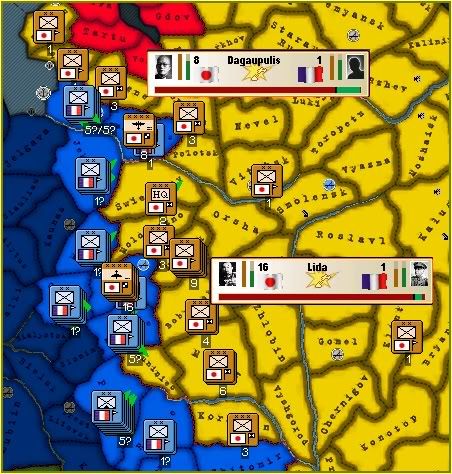
Hata's bomber groups routinely targetted newly advanced divisions as they occupied Japanese territory. Obata, now free from obligations in Finland, began to support the defences in the north as he attacked the single Allied division that had advanced into Dagaupulis and Shimoyama targetted the enemy troops in Lida.
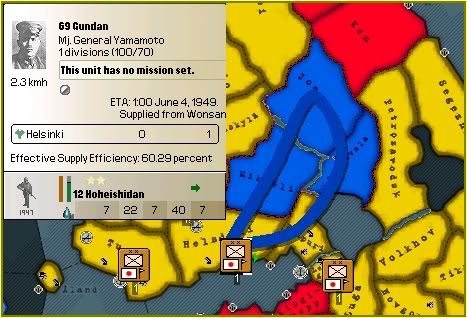
At 0800 hours Yamamoto moved into Helsinki to re-establish ground supplies to Japanese forces in Finland. He would need almost a month to retake other territory captured by the Americans.
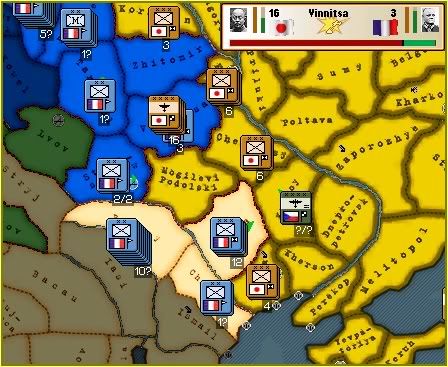
In the south Nakajima continued to pound the Allied troops in Vinnitsa as nine enemy divisions advanced into Balta threatening the Energy rich provinces to the east.
0000 May 9th 1949.
Africa Army Headquarters. Abadan, Persia.
The Japanese advance in Africa remained relatively slow and continued to be stopped periodically by the arrival of fresh French troops along the front lines.
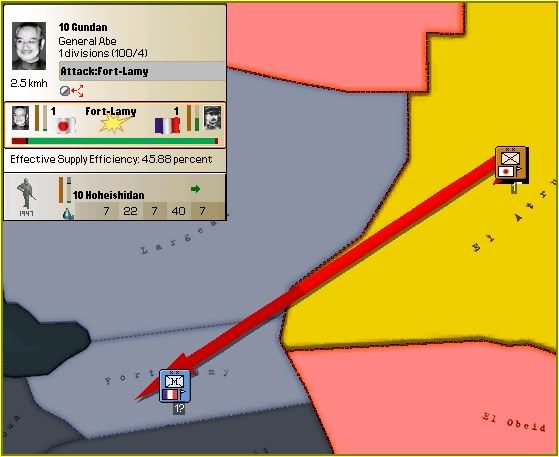
General Abe was forced to halt his march on Fort-Lamy after his tiring division encountered a freshly arrived French Militia division in the province.
0300 May 9th 1949.
Central Asia Army Headquarters. Sevastopol, Soviet Union.
The Allied attacks continued into May 9th as Hata's southern flank began to receive more attention from the large amount of enemy troops in the region.
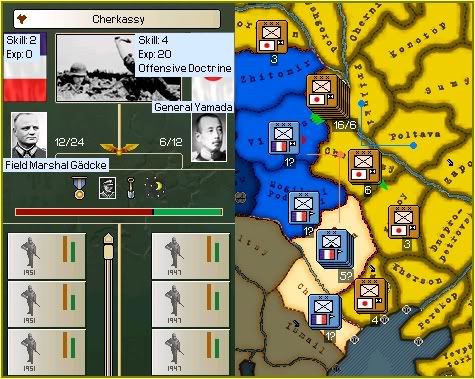
General Yamada would not be able to prevent Field Marshall Gadcke from advancing towards Cherkassy after his defences were assaulted by twice as many Allied divisions. Yamada's troops were ordered to withdraw towards Priluki and Poltava where they could benefit from a river defence.
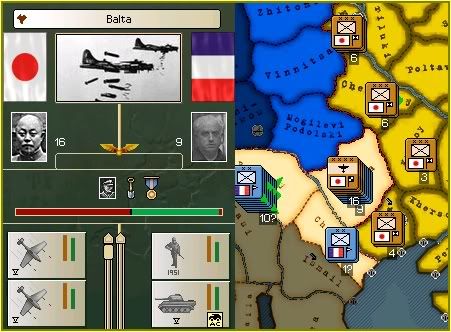
Having cleared Vinnitsa Nakajima moved his attention towards Balta where nine Allied divisions, including three Armoured, were trying to force a breakthrough in the south.
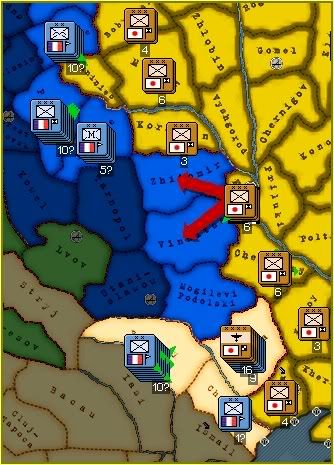
Hata decided to try and take advantage of the recent enemy losses adjacent to Kiev as he ordered troops to advance towards both Vinnitsa and Zhitomir. He was hoping to divert some attention away from the south as he had orders to protect the vast Energy reserves in the area.
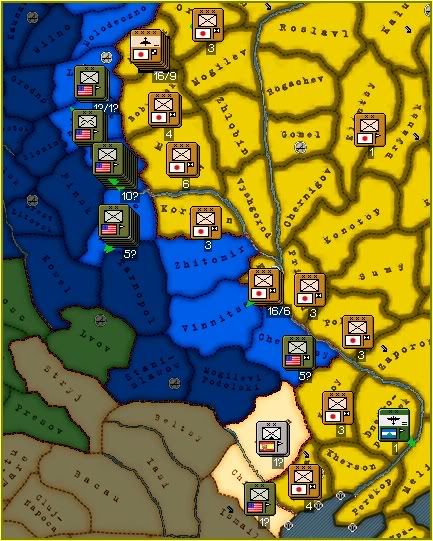
The picture altered dramatically along the Western Front on May 12th as the Allies made a clear change in Leadership throughout the region. Why control of the Allied Armies changed from France to the United States would remain a mystery but it initially looked to be of some benefit to Hata as several divisions were returned to their native Countries and began to make their way home.

The new Leadership wasted little time in continuing to apply pressure on the Japanese defensive line as General Nishio was forced to abandon Gulbene after being attacked by seven divisions commanded by Field Marshall Marshall. Losing Gulbene would isolate Japanese troops to the north until the Narva Kingisipp supply route was opened.
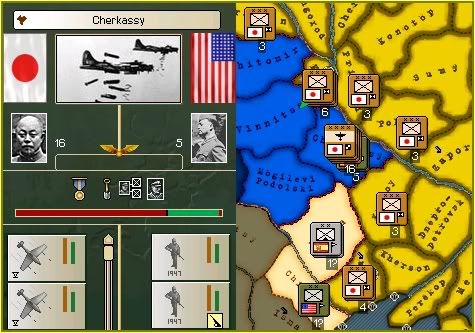
Five Allied divisions had moved into Cherkassy in the south where Nakajima began attacks against them to reduce their number and prevent any follow up attacks from this newly arrived force.
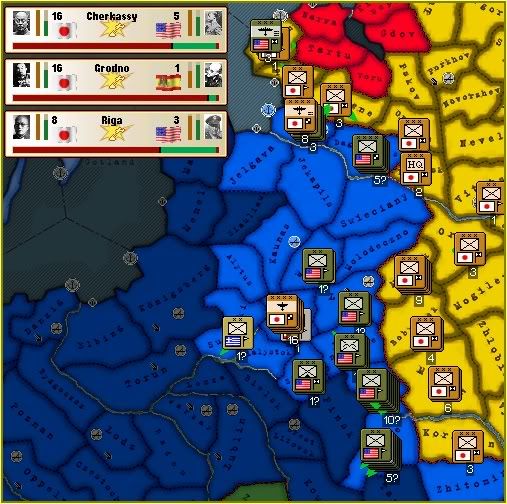
In the north Japanese bombers were targetting Marshalls' forces in Riga and a Spanish division behind the main Allied line in Grodno. Hata was beginning to notice a possible opportunity as a gap opened between the most advanced Allied forces and any relieving forces coming along behind.
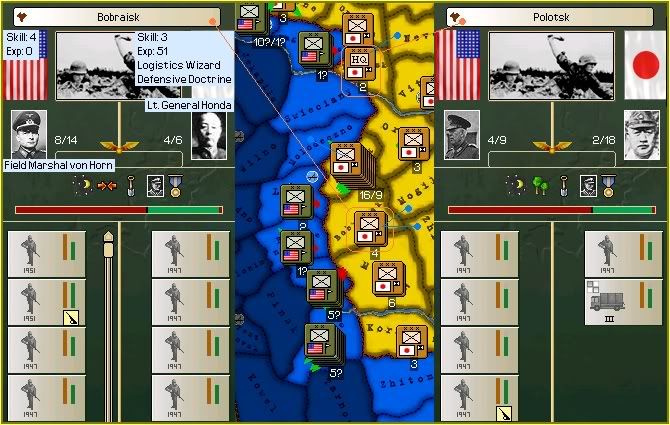
At 0300 hours on May 13th two more Allied attacks began in the north and center. Lt. General Honda would not be able to hold against Field Marshall von Horn in Bobraisk and his forces split as they withdrew east. In the north General Dohihara was also ordered to withdraw after he was attacked by four divisions in Polotsk. The entire front line was becoming much more fluid and Hata was happy to order advances of his own into the gap in the Allied lines to the north of Minsk.
The change in Leadership for the Allies, as well as repeated losses to air attacks, was beginning to thin out their lines somewhat, whereas the Japanese lines had merely withdrawn in the face of overwhelming numbers without significant losses. The balance of forces was slowly moving towards equilibrium, at which point the Imperial Japanese Airforce would become the overriding factor to drive the future of the Western Front.
The change in Leadership for the Allies, as well as repeated losses to air attacks, was beginning to thin out their lines somewhat, whereas the Japanese lines had merely withdrawn in the face of overwhelming numbers without significant losses. The balance of forces was slowly moving towards equilibrium, at which point the Imperial Japanese Airforce would become the overriding factor to drive the future of the Western Front.
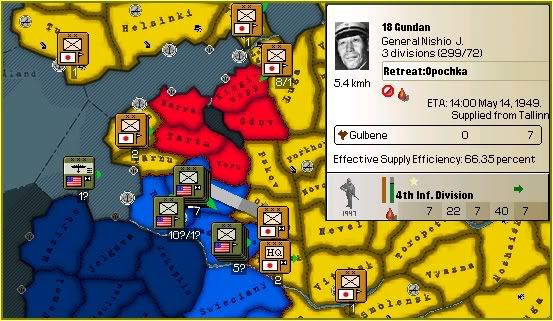
Nishio would not manage to make it to Opochka before the Americans captured Gulbene and severed the Japanese supply line to the Baltic Sea. The northern supply route was not too far from being opened and Hata was not overly concerned about losing his now isolated divisions.
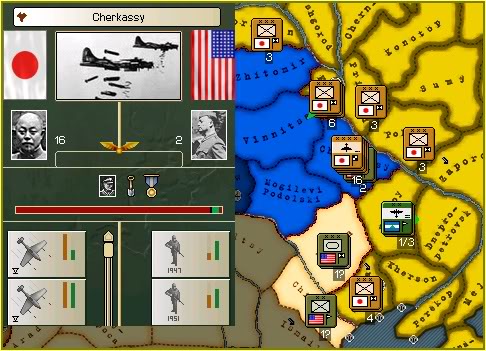
By 0400 hours on May 14th the Allied advance into Cherkassy was quickly turning into a slaughter as Nakajima decimated the Allied troops in the open terrain. Hata would wait a little while longer before ordering a counter attack.

The counter attack began ten hours later after Nakajima had destroyed the remaining two Allied divisions in Cherkassy. General Yamada led the advance. The Allies were responding in force to the losses in the south as a large number of dvisions headed towards the gap to try and seal it. Hata had abandoned the advance on Zhitomir after the Allies had captured Cherkassy as he had no wish to risk losing Kiev. Vinnitsa had been re-occupied though.

Lt. General Moruzumi began his march back to Kiev at 0000 hours on May 15th after he was attacked in Vinnitsa by four Allied divisions led by Lt. General Pitsikas.
0300 May 15th 1949.
Africa Army Headquarters. Abadan, Persia.
Trying to compare progress in Africa with that in Europe was pretty much a waste of time as conditions were completely different but Higashikuni could at least report a steady advance against a similar withdraw by Hata.
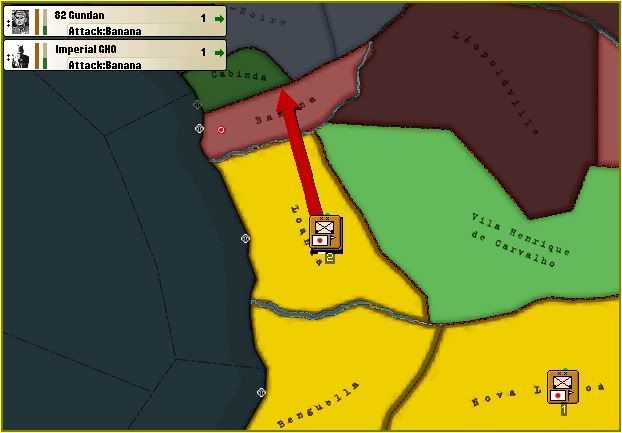
Japanese troops had managed to advance along the west African coast and began their march towards the Belgian capital in Banana. There were no defenders present for the time being.
0800 May 15th 1949.
Central Asia Army Headquarters. Sevastopol, Soviet Union.
The Western Front continued to change rapidly with more Allied advances leaving more opportunites for Hata to risk counter attacks against perceived weaknesses in the Allied line.

The Allied advance into Bobraisk had left the area behind the province considerably weaker so Hata ordered Hoshinato to lead the six Armoured divisions from Minsk towards the weak defences of Lida. The Allies had tried to close the gap somewhat from the north but it was still open and vunerable.
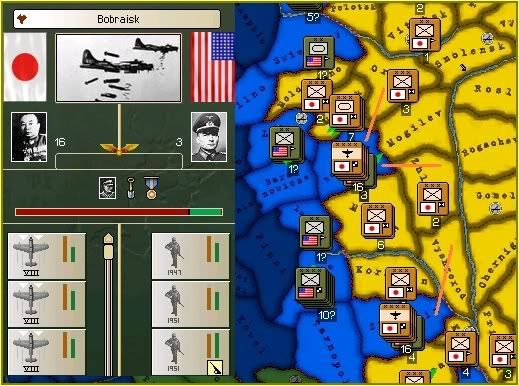
The occupation of Bobraisk did give the Allied Commanders some opportunities of their own which Hata was all to aware of. Any advances further east or north from Bobraisk could threaten to isolate Japanese troops in Minsk or the Prippit Marshes, particularly after four Allied divisions had moved into Zhitomir in the south. Shimoyama's Dive bomber group was ordered to remove any chance of that happening.
It appears that the change of leadership, with resulting redeployment of Allied divisions, has really sped up the possibility for a Japanese offensive towards Europe. Good news, that! I wonder if the French were running out of supplies?
I bet you cussed when the French deployed that silly militia unit in front of your advancing division in Fort-Lamy. Because it takes SOOOO long to advance between provinces, having to rest, reorganize and start marching again is quite the set back.
Keep up the good work!
-- Beppo
I bet you cussed when the French deployed that silly militia unit in front of your advancing division in Fort-Lamy. Because it takes SOOOO long to advance between provinces, having to rest, reorganize and start marching again is quite the set back.
Keep up the good work!
-- Beppo
Wow. After those long winter months I had almost forgotten what fluid warfare looks like. Just keep on reminding me. 
Also I have great confidence that the only once to encircle or isolate enemy divisions will be the Japanese. I don't think you will want to correct my assumption, will you?
Also I have great confidence that the only once to encircle or isolate enemy divisions will be the Japanese. I don't think you will want to correct my assumption, will you?
Very interesting situation around Minsk. The presence of Japanese armoured divisions makes me think of a swift movement towards Jekapils to cut off the Allied forces in and around Riga... Although there wouldn't be many reserves to protect the left flank of such an advance. Still, maybe...?
It appears Shimoyama's "Dive Bomber" Group is in reality an Interceptor Group, according to the last image.
Nice to see some oppurtunities show up in Europe. Does anyone have any clue why all the control would suddenly just got to America? Makes no sense.
Nice to see some oppurtunities show up in Europe. Does anyone have any clue why all the control would suddenly just got to America? Makes no sense.
I see the Allies have given you some breathing room...interesting.
I don't know...but I know they will be back soon. So Remble should take advantage of his window of opporunity.
Nice to see some oppurtunities show up in Europe. Does anyone have any clue why all the control would suddenly just got to America? Makes no sense.
I don't know...but I know they will be back soon. So Remble should take advantage of his window of opporunity.
Last edited:
It appears Shimoyama's "Dive Bomber" Group is in reality an Interceptor Group, according to the last image.
That should due to the interceptors escorting the CAS and being grouped together with them.
Approximately how much of the new situation is due to your bombers, and how much to inexplicable withdrawals?
I think the change of command happened because the french and french-controlled divisions were so far from their home country in foreign-occupied territory. Notice how all the territory occupied by the allies turned into US-controlled territory, not french-controlled. The French AI must have reasoned "This is none of our business, let's hand back all those German expeditionaries we don't need anymore and send our troops to the Americans who run this front anyways" so that's why 1) No more french controlled divisions 2) all the troops from the minor countries went back home.
That should due to the interceptors escorting the CAS and being grouped together with them.
I didn't ever notice that he had his Int's doing ground attack before.
I didn't ever notice that he had his Int's doing ground attack before.
Every little helps
Beppo - Some Allied troops left the front line which makes my life a little easier. I will still have to kill whatever troops left at some point. Africa is always difficult to move through, particularly with small forces, and I expect many such set backs.
Sokraates - Ground warfare is a welcome change even if I am going backwards for now. I cannot say which side isolates which troops, if indeed any such thing happens
Velko - Moving towards Riga or even further south is a possibility but I have to drain the Allied reserves marching that way to even attempt such a move.
Maj. von Mauser, Sokraates, Lützow, EnglandWarrior - The INT's are indeed supporting the CAS as they have been for months. I usually show the CAS but in screenshots where all attacking aircraft shown are INT's I have to use them.
In regards to the change in Allied command I really have no clue. Lutzow is probably at least partially correct but it could just be a line in the sand type of thing. A certain province may have triggered the change when the Allies captured it. I still have absolutely no idea why the French even got command in the first place as they had no direct land connection to the front.
Nathan Madien, EnglandWarrior - The change to a more fluid front line always benefits the side with air superiority as aircraft can close gaps fairly quickly if massive forces are not used. It is nice to be able to think about how to exploit weaknesses again though rather than just sitting back and letting them attack.
serutan - The majority is due to my bombers but some is certainly from withdrawing forces. On quite a few occasions the Allies advance with three or four divisions and they are wiped out by my bombers. This is the primary cause of vanishing Allied divisions.
Update to follow ...
Sokraates - Ground warfare is a welcome change even if I am going backwards for now. I cannot say which side isolates which troops, if indeed any such thing happens
Velko - Moving towards Riga or even further south is a possibility but I have to drain the Allied reserves marching that way to even attempt such a move.
Maj. von Mauser, Sokraates, Lützow, EnglandWarrior - The INT's are indeed supporting the CAS as they have been for months. I usually show the CAS but in screenshots where all attacking aircraft shown are INT's I have to use them.
In regards to the change in Allied command I really have no clue. Lutzow is probably at least partially correct but it could just be a line in the sand type of thing. A certain province may have triggered the change when the Allies captured it. I still have absolutely no idea why the French even got command in the first place as they had no direct land connection to the front.
Nathan Madien, EnglandWarrior - The change to a more fluid front line always benefits the side with air superiority as aircraft can close gaps fairly quickly if massive forces are not used. It is nice to be able to think about how to exploit weaknesses again though rather than just sitting back and letting them attack.
serutan - The majority is due to my bombers but some is certainly from withdrawing forces. On quite a few occasions the Allies advance with three or four divisions and they are wiped out by my bombers. This is the primary cause of vanishing Allied divisions.
Update to follow ...
Operation Influx
30
30
2300 May 16th 1949.
Central Asia Army Headquarters. Sevastopol, Soviet Union.
The Allied advance in the north was causing Hata some problems as supply lines became interupted in the Baltic States.
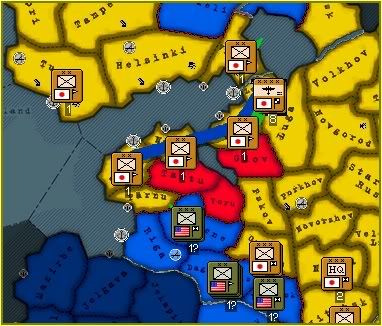
The occupation of Narvaa and Kingisepp allowed the supplies to begin flowing again with Obata moving his bomber group to Tallinn to allow shorter flights to attack the advancing enemy forces.
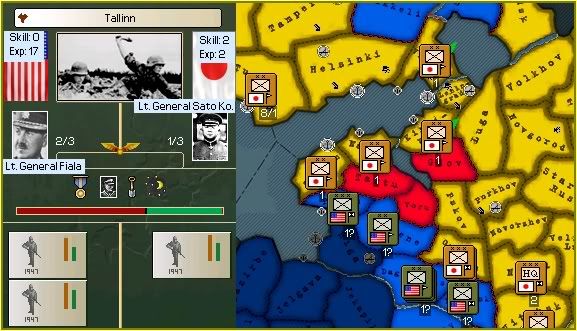
The loss of Parnu allowed the Americans to attack Tallinn which resulted in Lt. General Sato Ko being ordered to withdraw towards Narvaa. Obata moved to Turku in Finland to prevent his airfield being over run by the advancing enemy troops.
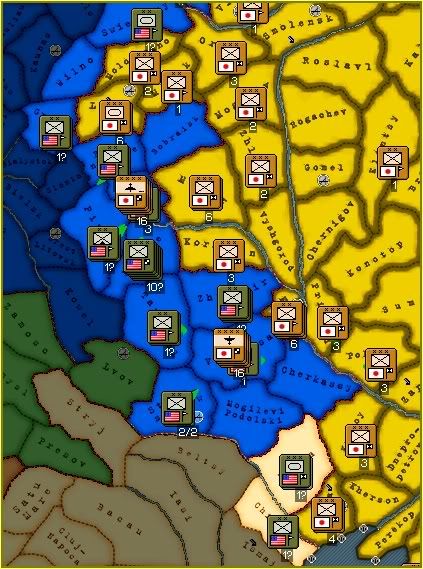
The remainder of the front line remained fluid as Allied troops continued to try and push forwards only to be destroyed by Shimoyama and Nakajima. Both bomber groups were still over worked and largely conducting attacks to allow Hata to maintain a defensive line.
Shimoyama had destroyed the three enemy divisions that had entered Bobraisk, which had removed the threat of possible encirclement for some of Hata's forces, and Nakajima was trying in vain to contain the Allied build up outside of Kiev as more and more American led troops advanced into Zhitomir and Vinnitsa. The point had still not been reached where the bombers could be allowed to target the rear area reinforcements which would allow Hata to launch a more wide spread offensive.
Shimoyama had destroyed the three enemy divisions that had entered Bobraisk, which had removed the threat of possible encirclement for some of Hata's forces, and Nakajima was trying in vain to contain the Allied build up outside of Kiev as more and more American led troops advanced into Zhitomir and Vinnitsa. The point had still not been reached where the bombers could be allowed to target the rear area reinforcements which would allow Hata to launch a more wide spread offensive.
0500 May 18th 1949.
Africa Army Headquarters. Abadan, Persia.
Higashikuni had a few worries of his own. He had a massive coastline to protect as well as a general offensive to conduct in Africa. The Imperial Japanese Navy was doing most of the work to protect against Allied invasion but the threat still existed.
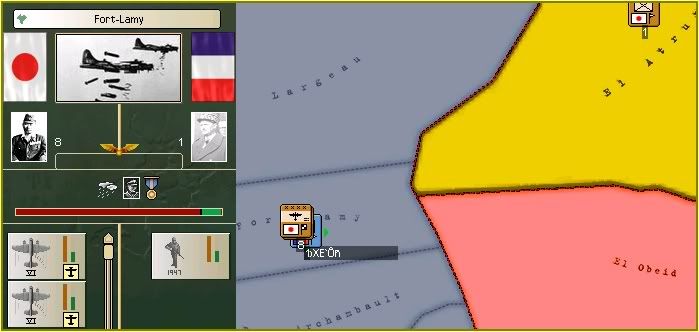
Itabana had been moved to support operations in the center of Africa where French troops were attempting to advance towards El Obeid. The bomber support for Higashikuni's troops would prevent any Allied advance but Itabana also had to remove resistance or Japanese forces could not move forwards as they were too few in number.
1300 May 18th 1949.
Central Asia Army Headquarters. Sevastopol, Soviet Union.
The initial Allied offensive had begun in the north but the south was beginning to show signs of more aggression. The north had been largely neutralised with the sides becoming a lot more even but in the south the Allies still held the edge.
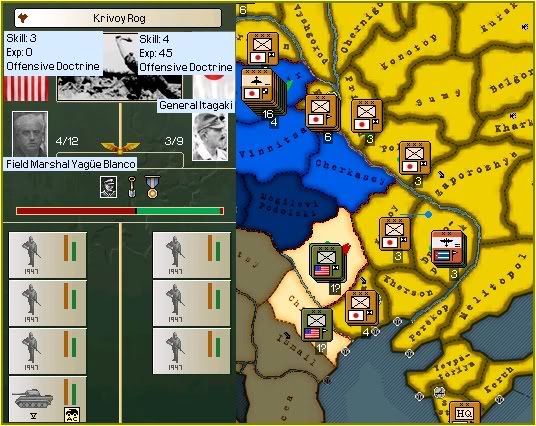
General Itagaki was ordered to withdraw from Krivoy Rog on May 18th after he was attacked by four enemy divisions from Balta. Hata could have allowed Itagaki to defend the province but again chose to minimise losses and cede territory for the time being.
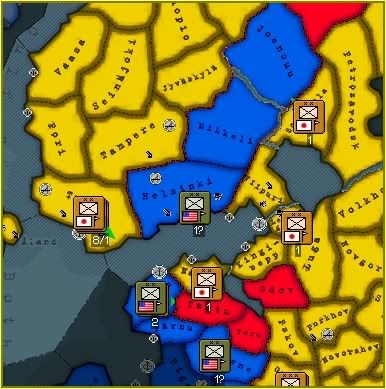
The Americans continued to vary their tactics in the north and another invasion in Helsinki temporarily cut supplies to the Japanese forces in Finland. Tallinn had also been lost to the advancing Allies but their numbers were decreasing to the point were a counter offensive could be considered.
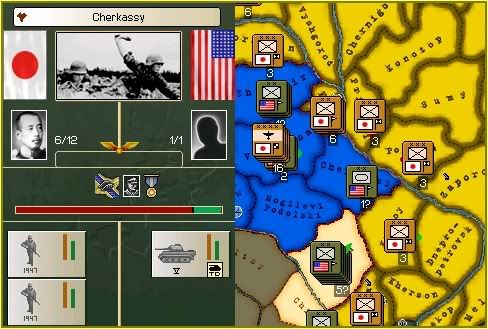
General Yamada's advance back towards Cherkassy met with some resistance at 0500 hours on May 19th as an Armoured division attemtped to block his path. He would overcome the defences and continue his march forwards.
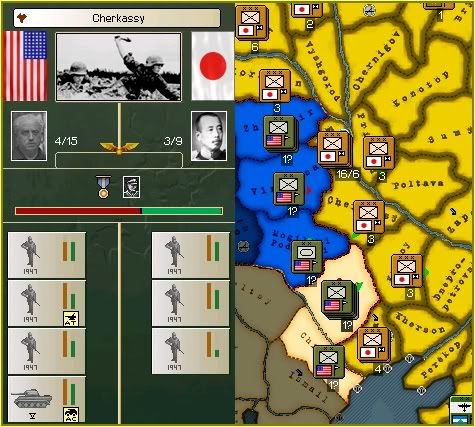
Yamada arrived in Cherkassy at 1100 hours and was immediately counter attacked by a superior Allied force. Hata did not issue orders to withdraw this time as another three Japanese divisions would arrive in two hours to support the defence. Cherkassy's defences would hold on this occasion but the Allies still had more reinforcements moving forwards.
0900 May 20th 1949.
Africa Army Headquarters. Abadan, Persia.
The almost constant threat of Allied invasion throughout Africa led to another landing taking place on May 20th. Higashikuni needed more bombers to support his advances across the continent as Itabana could not fly north and south indefinately.
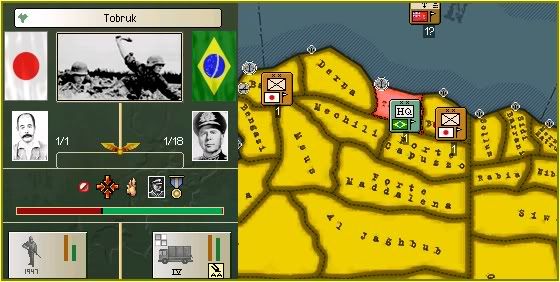
Tobruk was the latest target for the Allies as a Brazilian Headquarters divisions landed ahead of advancing Japanese troops which were to protect the province. No advance would be possible until air support arrived but the Japanese advance was wide enough now to prevent a single invasion from cutting supplies to the lead forces.
0500 May 21st 1949.
The Skies Above Sevastopol.
Hata had been attacked enough and there was little in the way of enemy air activity so he ordered an Interceptor wing to remove the bombers circling over Sevastopol.

Fukui would be the commander tasked with attacking the out dated Central American and Czech bombers. He destroyed one squadron and badly damaged most of the others before they could call off their bombing run.
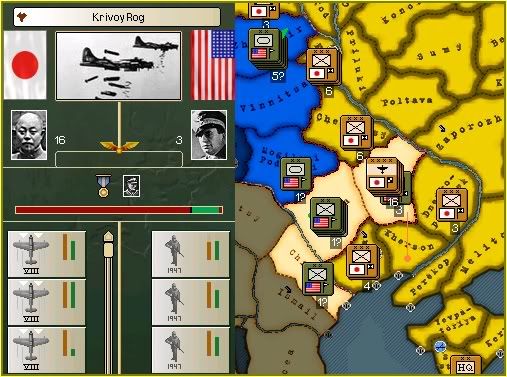
Further north Nakajima led his escorted Dive bomber group over Krivoy Rog where the latest Allied advance threatened to isolate four Japanese divisions defending Odessa.
1600 May 22nd 1949.
Africa Army Headquarters. Abadan, Persia.
The French forces in Africa were building up in the south and center and had become numerous enough in the south to begin to launch attacks against Higashikuni's smaller forces.
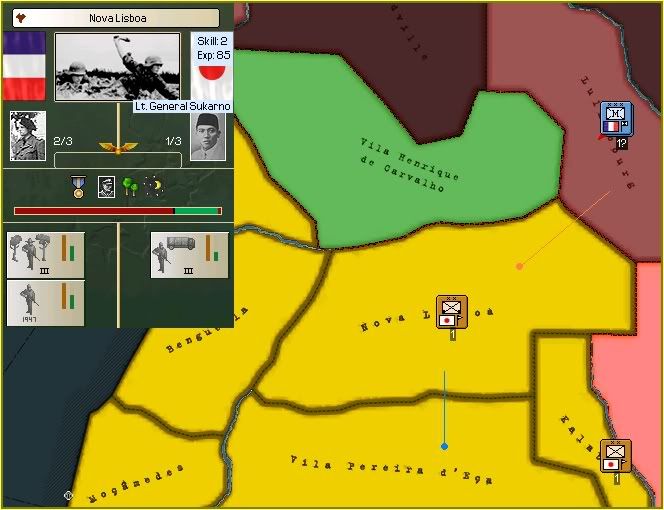
Lt. General Sukarno would not be able to hold Nova Lisboa after he was attacked by two enemy divisions. He was ordered to withdraw south after having spent weeks moving into Nova Lisboa. No air support was currently available in this region as it was too far from a friendly air base.
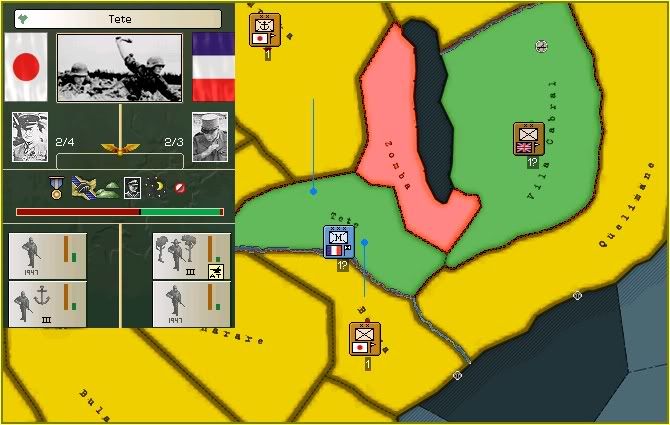
Shortly afterwards the advance in the south east also stalled after more enemy troops redeployed into Tete province. The enemy troops were doomed as they had not managed to arrive before this part of Africa had been isolated by Japanese forces. At least three Allied divisions were now hopelessly cut off behind enemy lines.
2200 May 22nd 1949.
Central Asia Army Headquarters. Sevastopol, Soviet Union.
Towards the end of May 22nd Nakajima had removed the enemy forces in Krivoy Rog which allowed General Itagaki to move back towards the province to solidify the southern defensive line.
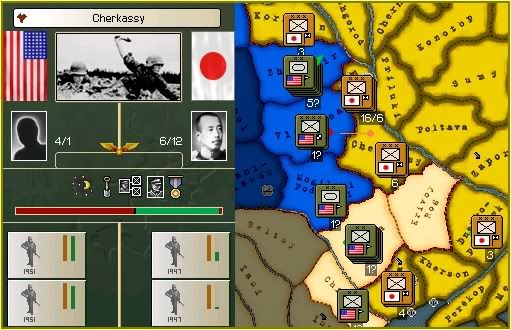
Yamada was attacked again in Cherkassy which was proving to be the focal point of the Allied attempts to advance in the south. He would hold against inferior numbers.
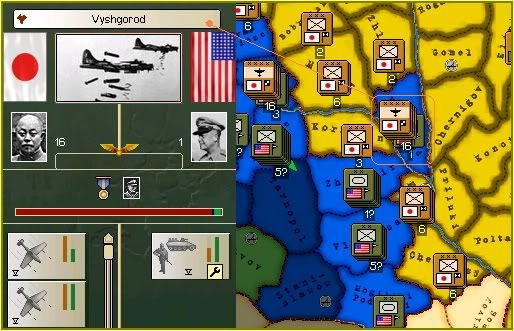
An Allied Mechanised division, led by Eisenhower, advanced into Vyshgorod in the late afternoon of May 25th where it immediately drew the attention of Nakajima and his Dive bomber group. The latest attacks and advances pointed to an Allied attempt to encircle Kiev but it was not making enough headway to be of any serious threat.
2100 May 23rd 1949.
BB Division 1 Flagship. IJN Fuso, Cape Alguhas.
Ozawa had moved his Carrier Groups north and moved BB Division 1 south to patrol around the Cape off southern Africa.
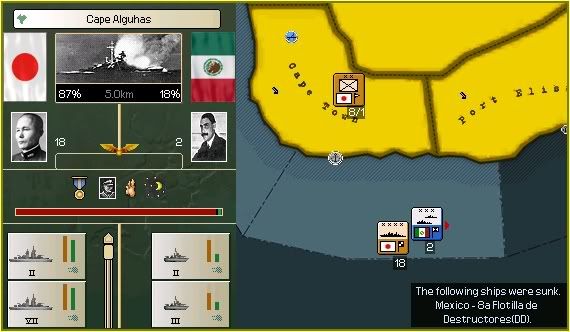
Battleships were more versatile at attacking small Allied fleets as they were not limited during night and bad weather as much as Carrier Air Groups were. Both Mexican Destroyer Flotillas were sunk but only one would be credited to a Japanese ship. IJN Fuso's guns sank 8a Flotilla de Destructores.

